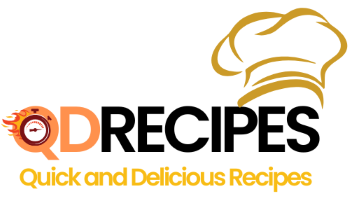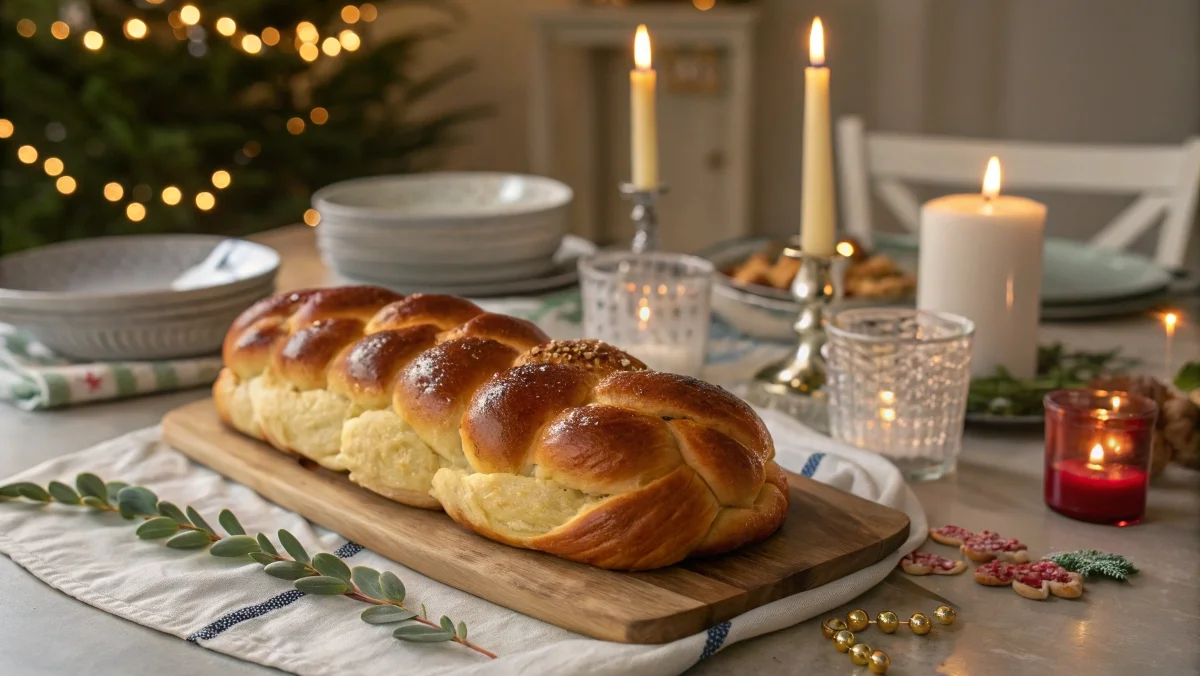Bread lovers often find themselves pondering an intriguing question: Is braided brioche the same as challah? At first glance, these two stunningly braided loaves seem like twins separated at birth—soft, golden, and utterly irresistible. But what if I told you they come from two completely different worlds? One bite into each, and you’ll discover a delightful journey of flavors, traditions, and textures that set them apart. Whether you’re a seasoned baker or just someone with a sweet spot for bread, uncovering the nuances of these iconic loaves is like opening a treasure chest of culinary stories.
Now, imagine creating recipes with the perfect bread, one that complements every flavor you love. Braided brioche and challah each bring something unique to the table, from a delicate sweetness to a rich, buttery aroma. But knowing when to choose which can make all the difference. Keep reading, and you’ll unlock the secrets to using these breads in ways that will wow your taste buds!
Table of Contents
Understanding the Unique Characteristics of Braided Brioche
Ingredients and Texture of Brioche
Brioche is a luxurious bread known for its rich ingredients and tender texture. It often contains butter, milk, and eggs, which give it a soft crumb and a slightly sweet flavor. Unlike challah, brioche has a higher fat content, making it more indulgent. So, is braided brioche the same as challah? While both are soft, golden breads, the richness of brioche, especially with its butter content, sets it apart. First, its fluffy interior melts in your mouth, perfect for desserts or savory dishes. Next, the golden crust offers a slight crispness that contrasts beautifully with the soft inside
For clarity, here’s a quick comparison:
| Ingredient | Brioche |
|---|---|
| Butter | High Content |
| Eggs | More Richness |
| Sweetness Level | Mildly Sweet |
Also, brioche’s versatility in recipes makes it a favorite for everything from French toast to gourmet sandwiches. If you’ve never tried it, you’re in for a treat!
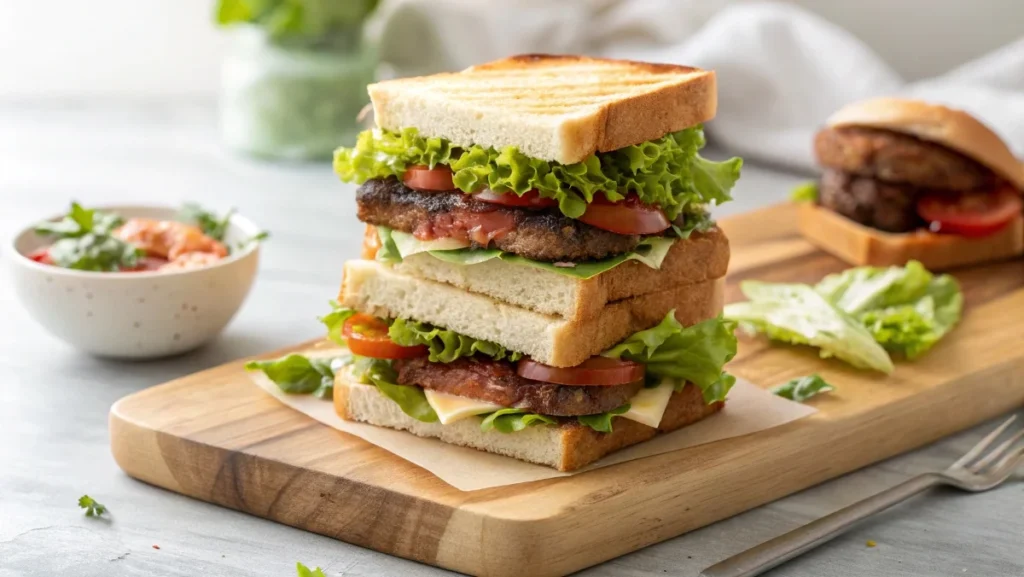
Traditional Uses of Brioche in Baking
Brioche has been a beloved choice in baking for centuries. Traditionally, it’s used in breakfast dishes like French toast and as a base for decadent desserts. You’ll also find it in savory options such as sliders and stuffed breads. Its richness works well in both sweet and savory recipes, making it a staple in many kitchens. But is braided brioche the same as challah? While both are braided, their ingredients and flavor profiles set them apart, with brioche often offering a richer, butterier taste.
For more clarity, here’s a table of popular brioche uses:
| Dish | Sweet or Savory |
|---|---|
| French Toast | Sweet |
| Brioche Sliders | Savory |
| Pastry Dough | Sweet |
| Stuffed Loaves | Savory |
Brioche is like the Swiss Army knife of bread. You can use it almost anywhere, and it always tastes amazing. Plus, its soft, buttery texture is hard to resist!
The History and Cultural Significance of Challah
Symbolism and Traditions Behind Challah
Challah is more than just bread; it’s a symbol of tradition and togetherness. Its braided design reflects unity, and it’s often used during religious and family celebrations. First, challah’s round shape during certain holidays symbolizes life and continuity. Then, the three-strand braid represents love, peace, and harmony. But is braided brioche the same as challah? While both can be braided, challah carries deep cultural significance, especially in Jewish traditions, making it distinct from the buttery richness of braided brioche.
Challah isn’t just beautiful—it’s meaningful. When shared, it connects people, making every meal feel special. Whether it’s Friday dinner or a festive gathering, challah always brings warmth to the table.
How Challah Evolved Over Time
Challah has evolved alongside its cultural roots. Originally made with simple ingredients, it now features variations like whole wheat or seeded toppings. Also, the braiding styles have expanded, adding creativity to its traditional look. Is braided brioche the same as challah? While both can feature intricate braiding, challah has adapted through generations with different flavors and toppings, maintaining its cultural roots, unlike braided brioche, which focuses more on richness and texture.
Key points to illustrate challah’s evolution:
- Traditionally simple ingredients like flour, water, and eggs.
- Modern twists include toppings like sesame or poppy seeds.
- Varied shapes: three-strand braids, rounds, or elaborate weaves.
This adaptability keeps challah timeless, bridging past traditions with present-day creativity.
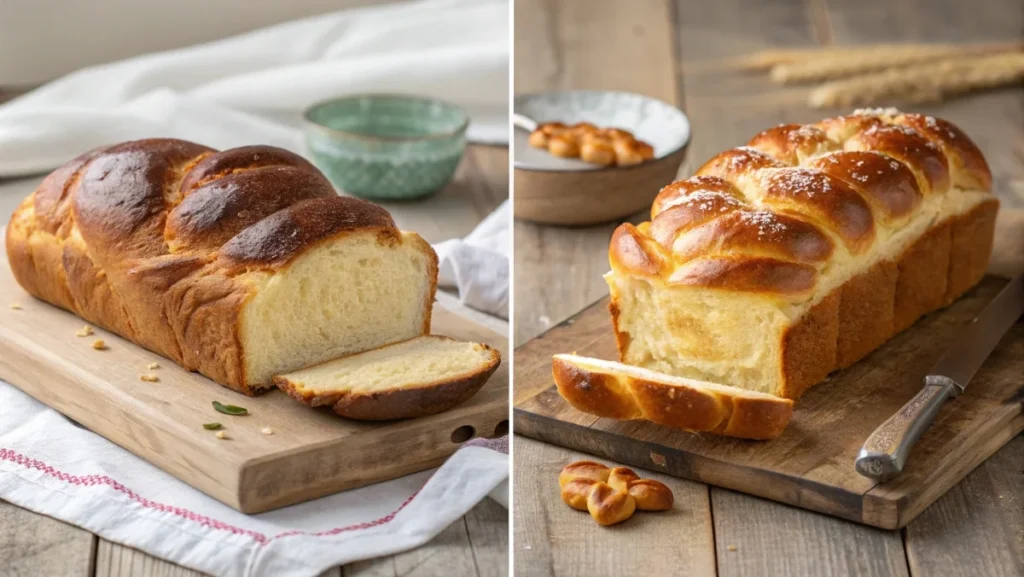
Key Differences Between Brioche and Challah
Variations in Ingredients and Sweetness Levels
Brioche and challah might look similar, but their ingredients set them apart. Brioche uses butter, while challah is oil-based, making the latter lighter and suitable for various diets. Brioche is slightly sweet, but challah’s sweetness depends on the recipe. Is braided brioche the same as challah? While both are often braided, their ingredient differences give each bread its unique taste and texture, making them distinct from one another.
For better understanding, see this table:
| Feature | Brioche | Challah |
|---|---|---|
| Main Fat Source | Butter | Oil |
| Sweetness Level | Mild | Variable |
| Dietary Consideration | Rich | Lighter |
Each bread has its charm, but knowing their differences helps you choose the right one for your recipe.
Baking Techniques and Flavor Profiles
Their baking techniques also differ. Brioche’s butter-rich dough rises slowly, creating its airy texture. Challah, on the other hand, is kneaded longer for elasticity. The flavors reflect these techniques: brioche is buttery and rich, while challah is light and slightly sweet. Is braided brioche the same as challah? The difference in their baking methods highlights their distinct textures and flavors, showcasing how each bread has its own unique process.
Bullet points for clarity:
- Brioche: Slow rise for fluffiness; buttery flavor.
- Challah: Longer kneading; elastic and slightly sweet.
Each method highlights the unique qualities of these breads, making them shine in their own way.
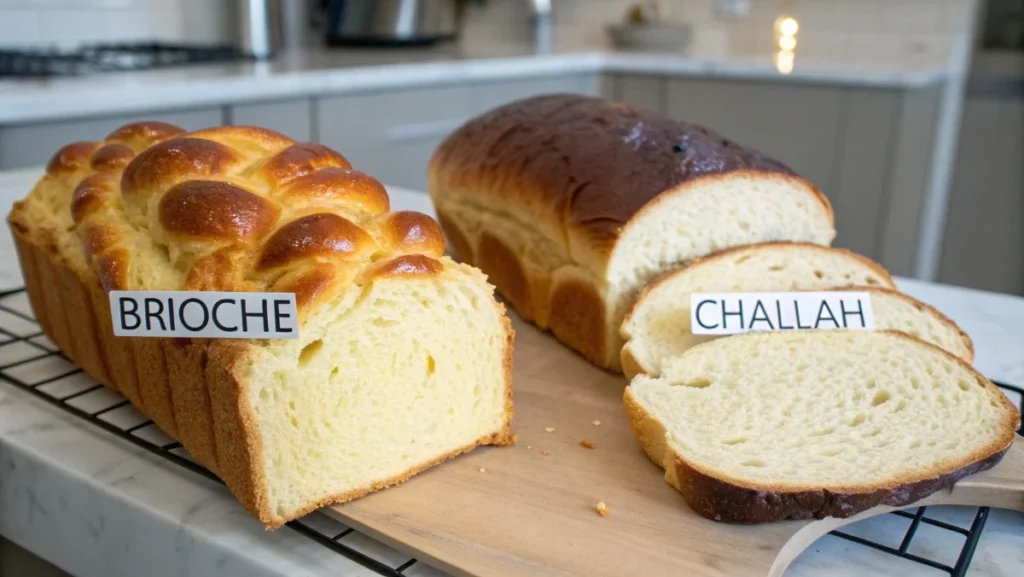
When to Choose Braided Brioche or Challah for Your Recipes
Suitable Dishes for Braided Brioche
Braided brioche is perfect for indulgent recipes. Its rich flavor elevates dishes like bread pudding or gourmet sandwiches. Next, its soft texture pairs well with spreads or creamy fillings. Finally, it’s excellent for festive occasions when you want something luxurious. Is braided brioche the same as challah? While both are braided, braided brioche’s rich, buttery flavor makes it ideal for more indulgent dishes, setting it apart from challah.
Best Recipes to Highlight Challah’s Flavor
Challah’s light texture makes it versatile for many recipes. You’ll love it in French toast, bread puddings, or as a side for savory meals. It also works well in braided loaves with added toppings like sesame seeds.
Bullet points for clarity:
- Ideal for French toast and bread pudding.
- Complements savory dishes like soups or stews.
- Perfect with seeded toppings for added crunch.
Whichever bread you choose, your recipes are sure to shine!
“Now that we’ve uncovered the charm of challah, it’s time to roll up your sleeves and turn this braided beauty into something irresistibly savory—let’s dive into these delicious Herb and Garlic Challah Knots!”
Savory Herb and Garlic Challah Knots
Ingredients
Creating these savory challah knots is like crafting a work of art! Each ingredient plays its part beautifully:
- 1 1/2 cups Warm Water – This helps activate the yeast, giving your dough its fluffy texture. Think of it as the secret to a soft, cloud-like bread.
- 2 teaspoons Honey – A natural sweetener that not only feeds the yeast but also adds a hint of sweetness. It balances the garlic’s boldness.
- 1 envelope Rapid Active Dry Yeast – This little powerhouse brings the dough to life, making it rise to perfection.
- 2 tablespoons Melted Butter – Adds richness and keeps the knots tender. It’s like the ingredient that ties everything together.
- 2 teaspoons Kosher Salt – Essential for flavor, it enhances every bite and complements the garlic butter topping.
- 3 1/2 cups Flour (plus more for dusting) – The backbone of the recipe, flour creates the structure. Dusting prevents sticking during shaping.
- For the Garlic Butter:
- 1 stick Unsalted Butter – The star of the topping, melting to coat each knot with savory goodness.
- 6 cloves Garlic, minced – Fresh garlic infuses each knot with its irresistible aroma and taste.
- 1 teaspoon Garlic Salt – Adds an extra kick of garlic flavor.
- 1/2 cup Fresh Parsley, chopped – Bright and herbaceous, parsley adds freshness and a pop of color.
Step-by-Step Instructions
Let’s turn these simple ingredients into irresistible savory knots:
- Activate the Yeast – In a bowl, mix warm water, honey, and yeast. Let it sit for 5 minutes until frothy. This step ensures your yeast is alive and ready to work its magic.
- Make the Dough – Combine melted butter, salt, and flour with the yeast mixture. Knead the dough for 8-10 minutes until smooth. This creates the perfect chewy texture.
- Let It Rise – Cover the dough and let it rise in a warm place for an hour. It should double in size. This gives the knots their airy, soft texture.
- Shape the Knots – Divide the dough into equal pieces, roll them into ropes, and tie each into a knot. Dust with flour if needed.
- Prepare the Garlic Butter – Melt butter, stir in minced garlic, garlic salt, and parsley. Brush this over the knots generously.
- Bake to Perfection – Bake at 375°F (190°C) for 20-25 minutes until golden. Brush with more garlic butter before serving.
Serving
This recipe makes 12 savory herb and garlic challah knots.
- Serve them warm, straight from the oven, for the ultimate comfort food experience.
- Pair with marinara sauce for dipping or a fresh side salad for a complete meal.
- For a fun twist, sprinkle grated parmesan over the knots before baking for an extra cheesy touch.
Tips and Hacks
Take your challah knots to the next level with these tips:
- For an Extra Fluffy Dough – Add an additional tablespoon of honey during the kneading process.
- Herb Variations – Swap parsley for rosemary or thyme for a different herb flavor profile.
- Make Ahead – Shape the knots, then refrigerate them overnight. Bake fresh the next day.
- Storage – Store leftover knots in an airtight container. Reheat in the oven for 5 minutes for a just-baked taste.
Nutrition Facts
Serving size: 1 knot
Calories: 200
Fat: 10g
Carbs: 25g
Protein: 4g
Sodium: 350mg
Fiber: 1g
Please note: Nutritional values are approximate and depend on ingredient brands and portion sizes.
Prep Time
Prep time: 20 minutes
Cook time: 25 minutes
Total time: 1 hour 45 minutes
Please note: Times are estimated and may vary based on individual preparation methods.
When serving Savory Herb and Garlic Challah Knots, consider pairing them with these delightful dishes from our collection:
- Braided Chocolate Chip Brioche Recipe: A sweet and indulgent treat that complements the savory knots.
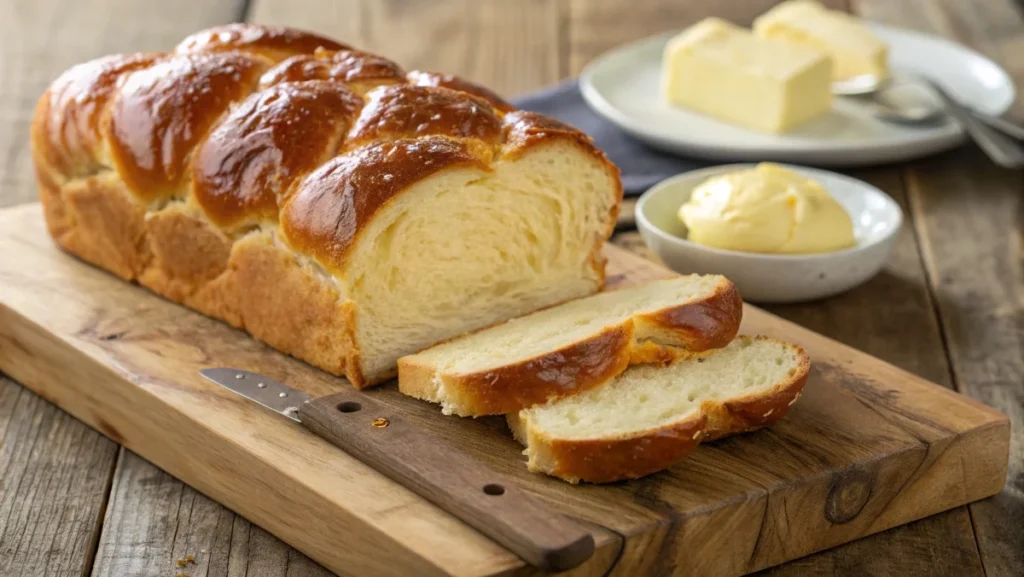
Frequently Asked Questions (FAQs)
Are brioche and challah the same?
Brioche and challah share similarities, but is braided brioche the same as challah? They are not the same. Both are rich, soft breads, often braided, and made with love. However, brioche uses butter for its signature richness, while challah uses oil. This difference gives each bread a unique flavor and texture. Also, challah is a traditional Jewish bread with cultural significance. Both are delicious, so you’re in for a treat with either!
Is braided bread challah?
Here’s the revised paragraph with the keyphrase added:
Not all braided bread is challah, but is braided brioche the same as challah? Not exactly. Braiding adds a beautiful touch, making it stand out. Challah is specifically tied to Jewish traditions and uses oil instead of butter. On the other hand, braided bread can include varieties like brioche. So, while they look similar, they might taste different. Next time you see braided bread, check its ingredients for a fun discovery!
What is the name of the braided brioche?
Is braided brioche the same as challah? Braided brioche doesn’t have a specific name, but it’s often called braided brioche! This bread showcases a rich, buttery taste with a soft texture. Its braids make it look stunning and irresistible. Sometimes, it’s flavored with vanilla or orange zest for extra flair. Serve it at breakfast, brunch, or even dessert. Braided brioche is a showstopper for any occasion, blending beauty with taste perfectly.
What is a substitute for challah bread?
Is braided brioche the same as challah? If you can’t find challah, don’t worry! Brioche is a great substitute due to its similar texture. You can also use egg bread or even a soft white loaf. For a dairy-free option, try homemade challah with oil. Each substitute brings its twist, so explore what works for you. Pair with soups, sandwiches, or dips for an equally satisfying experience.
A Delicious Bread Journey to Savor
Is braided brioche the same as challah? Exploring the differences between brioche and challah is like a fun culinary adventure. Both breads are rich, soft, and irresistibly tasty. However, their ingredients and traditions set them apart. Brioche uses butter for its unique flavor, while challah opts for oil, keeping it dairy-free. Their beautiful braids also add to their charm. First, try baking one, then the other, and savor the variety. You’ll love the discovery!
